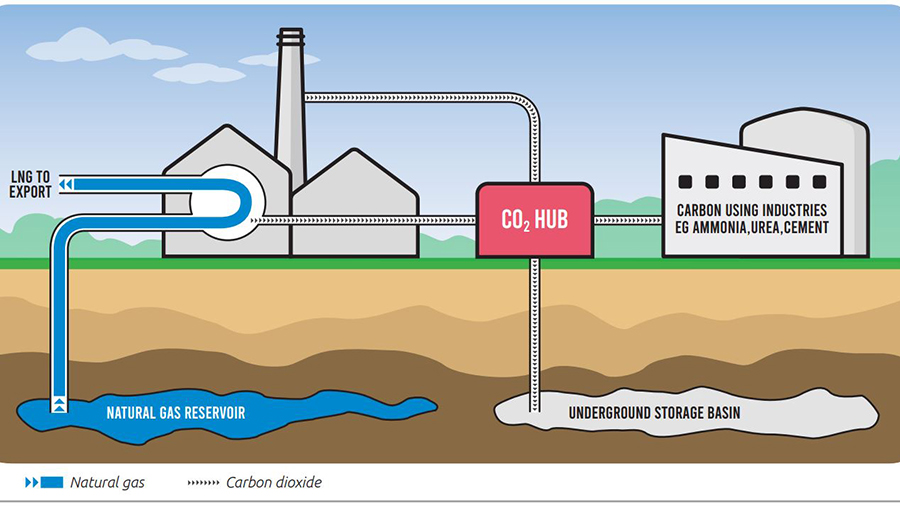Carbon capture, utilisation and storage
The Northern Territory Government is working to transform Middle Arm into a sustainable ‘development ready’ industrial precinct. The precinct aims to capitalise on the Territory’s lower emission gas and renewable energy potential to grow manufacturing and value-adding jobs while supporting economic growth.
The precinct will be a master planned area with a focus on low emission liquid natural gas, advanced manufacturing, carbon capture, utilisation and storage (CCUS), mineral processing, and hydrogen.
What is carbon capture, utilisation and storage
Carbon capture, utilisation and storage (CCUS) is a proven process that captures carbon dioxide emissions, preventing entry into the atmosphere. Broadly the process covers the following:
Capture
Technical process that captures carbon dioxide (CO2) in a gas or exhaust stream. The techniques of capturing carbon typically use a process requiring a catalyst or membrane to separate the carbon from a mix of other gases.
Utilisation
Turning carbon that would otherwise be waste into a feedstock (or input) for another industry or purpose.
Storage
Transport for permanent storage underground in stable geological formations (porous underground rock). According to the International Energy Agency, carbon capture and storage has an important role to play in the global transition to net zero emissions.
Carbon capture, utilisation and storage at Middle Arm
CCS involves capturing CO2 emissions produced by industry before they are released into the atmosphere. Technology is also being developed that will allow the removal of CO2 from the atmosphere through a process called direct air capture.
Once captured, carbon dioxide is then compressed, sent down pipelines or wells and safely stored deep underground.
Captured carbon dioxide can also be transported by vehicle or ships between sources of carbon dioxide emissions (including other countries) and storage locations (like the Territory) to help them meet emission reduction targets.
Providing a CCS facility is a significant economic and environmental opportunity for the Territory.
The Middle Arm Sustainable Development Precinct will feature one of the world’s largest CCS facilities. It will capture 90% of emissions from that precinct and can also store emissions from other countries.
Captured carbon will be stored deep underground in depleted off-shore natural gas wells - north of Darwin - using existing infrastructure.
CCS has been safely used at commercial levels since 1997 with more than 30 CCS facilities in operation around the world.
The number of facilities is expected to grow rapidly as countries work towards reaching net zero by 2050.
CCUS is a critical emissions reduction technology supporting clean energy transitions. The proposed hub at Middle Arm will be one of the world’s largest facilities of its kind and will enable:
- existing LNG production to continue and grow with a significantly lower carbon footprint
- establishment of new low-emission hydrocarbon and hydrogen based industries.
Once carbon is captured at, or transported to, the proposed hub at the precinct, it will either be stored underground or used to produce other valuable products.
An example of carbon being utilised, or reused, is using carbon to make urea, a common fertiliser. Another example is cement manufacturers developing technologies to inject carbon into their manufacturing process.
This improves product performance and offsets emissions. The Northern Territory Government in partnership with the CSIRO, industry and engineering companies are collaborating on a business case to map an accelerated pathway to establishing CCUS at Middle Arm.
Current carbon capture and storage projects at Middle Arm
Two offshore carbon storage projects are currently proposed or underway at Middle Arm. Both projects will include capturing carbon onsite then transporting it offshore for storage.
INPEX is leading progression of the Bonaparte CCUS Project in the Petrel Sub-basin. Assessments have indicated the basin has a lifetime storage capacity of 6.48 gigatonnes. This is equivalent to storing Australia’s current entire yearly carbon emissions for 16 years in one basin.
Additionally, the proposed Bayu-Undan Santos-led project in the Timor Sea entered front-end engineering and design in 2022 with the potential to store up to 10 million tonnes of carbon each year.
Successful carbon capture, utilisation and storage projects around the world
According to the International Energy Agency, CCUS facilities currently capture almost 45 megatonnes of carbon dioxide globally. There are around 35 commercial facilities applying CCUS to industrial processes, fuel transformation and power generation with around 300 projects in various stages of development.
The Sleipner CCS project was the world’s first commercial CO2 storage project. It commenced in 1996 in response to Norwegian Government policies. CO2 is removed from the hydrocarbons produced at an offshore platform then pumped back into the ground. By May 2008, the project had successfully stored over 10 million tonnes of CO2.
Considerable resources are being dedicated to growing CCUS around the world. Here in Australia the country’s leading carbon capture, utilisation and storage research organisation, CO2CRC, has more than 19 years of experience safely capturing, storing and monitoring CO2.
As of 2022, the organisation has stored more than 95,000 tonnes of CO2. CO2CRC owns and operates the Otway International Test Centre, a world class test facility focused on advancing CCUS technology in Australia and around the world.
